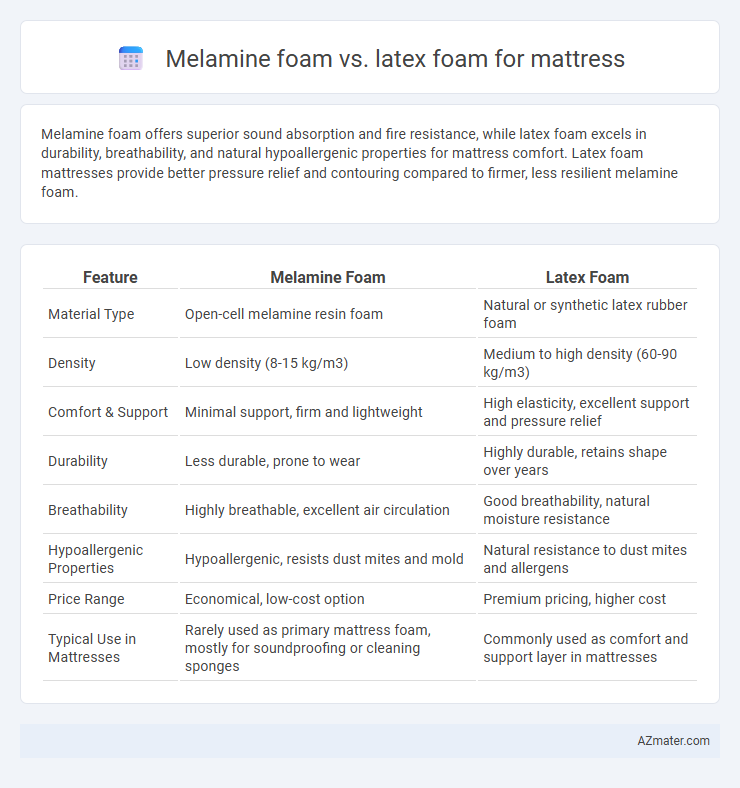Melamine foam offers superior sound absorption and fire resistance, while latex foam excels in durability, breathability, and natural hypoallergenic properties for mattress comfort. Latex foam mattresses provide better pressure relief and contouring compared to firmer, less resilient melamine foam.
Table of Comparison
| Feature | Melamine Foam | Latex Foam |
|---|---|---|
| Material Type | Open-cell melamine resin foam | Natural or synthetic latex rubber foam |
| Density | Low density (8-15 kg/m3) | Medium to high density (60-90 kg/m3) |
| Comfort & Support | Minimal support, firm and lightweight | High elasticity, excellent support and pressure relief |
| Durability | Less durable, prone to wear | Highly durable, retains shape over years |
| Breathability | Highly breathable, excellent air circulation | Good breathability, natural moisture resistance |
| Hypoallergenic Properties | Hypoallergenic, resists dust mites and mold | Natural resistance to dust mites and allergens |
| Price Range | Economical, low-cost option | Premium pricing, higher cost |
| Typical Use in Mattresses | Rarely used as primary mattress foam, mostly for soundproofing or cleaning sponges | Commonly used as comfort and support layer in mattresses |
Introduction to Melamine Foam and Latex Foam
Melamine foam is a lightweight, open-cell material known for its excellent sound absorption and thermal insulation properties, making it popular in mattress toppers for comfort and temperature regulation. Latex foam, derived from natural or synthetic latex, offers superior elasticity, durability, and pressure relief, providing a responsive and supportive sleep surface. Both materials enhance mattress performance, catering to different preferences in firmness, breathability, and hypoallergenic qualities.
Composition and Material Properties
Melamine foam is a rigid, lightweight material composed of a melamine-formaldehyde resin network, known for its open-cell structure and excellent sound absorption and thermal insulation properties. Latex foam, derived either naturally from rubber tree sap or synthesized chemically, offers high elasticity, durability, and breathability with a dense, resilient structure that adapts to body contours. Differences in composition result in melamine foam being mostly used in insulation and cleaning applications, while latex foam excels in mattress comfort and support, providing pressure relief and hypoallergenic benefits.
Comfort and Support Comparison
Melamine foam offers excellent sound insulation properties but is less resilient and provides firmer comfort compared to latex foam, which is known for superior elasticity and pressure relief. Latex foam contours closely to the body, enhancing support and reducing pressure points, while melamine foam's rigid structure can lead to uneven weight distribution. For mattress applications, latex foam is generally preferred for prolonged comfort and adaptive support, whereas melamine foam is more suitable for limited cushioning needs.
Durability and Longevity
Melamine foam typically offers high durability due to its resistance to compression and deformation, making it suitable for long-term use in mattresses. Latex foam is renowned for its exceptional longevity, maintaining its shape and support for over a decade without significant breakdown. Both materials provide durable mattress options, but latex foam generally surpasses melamine foam in lifespan and consistent performance.
Temperature Regulation and Breathability
Melamine foam offers excellent breathability due to its open-cell structure, allowing for superior airflow and effective temperature regulation in mattresses. Latex foam, while slightly denser, provides natural temperature control through its inherent moisture-wicking properties and ability to conform closely to the body, reducing heat buildup. For optimal cooling performance, melamine foam excels in breathability, whereas latex foam balances comfort with moderate temperature regulation.
Allergy and Health Considerations
Melamine foam is a highly effective sound absorber but can release formaldehyde and other volatile organic compounds (VOCs) that may trigger allergies and respiratory issues in sensitive individuals. Latex foam, especially natural latex, is hypoallergenic, resistant to dust mites, mold, and mildew, making it a better option for allergy sufferers and those concerned about indoor air quality. Choosing natural latex foam reduces exposure to chemical irritants commonly found in synthetic foams like melamine, promoting a healthier sleep environment.
Eco-Friendliness and Sustainability
Melamine foam is a synthetic material known for its excellent sound absorption and thermal insulation properties but is less eco-friendly due to its non-biodegradable nature and reliance on petrochemical processes. Latex foam, especially organic natural latex derived from rubber trees, offers superior sustainability through biodegradability, renewable sourcing, and minimal chemical processing. Choosing natural latex foam over melamine aligns better with environmentally responsible mattress manufacturing and reduces ecological impact.
Cost and Value Analysis
Melamine foam mattresses typically offer a lower upfront cost compared to latex foam, making them an affordable option for budget-conscious consumers. Latex foam provides superior durability and natural resilience, resulting in enhanced long-term value despite higher initial investment. The cost-effectiveness of melamine foam may be offset by its shorter lifespan and reduced comfort retention relative to latex foam mattresses.
Best Use Cases for Each Foam Type
Melamine foam is best suited for soundproofing and thermal insulation in mattresses due to its open-cell structure and excellent noise reduction properties, making it ideal for individuals seeking a quieter sleep environment. Latex foam excels in providing responsive support and pressure relief, with natural elasticity and durability that benefit those with joint pain or seeking eco-friendly, hypoallergenic mattress options. Each foam type addresses specific needs: melamine foam focuses on noise and temperature control, while latex foam prioritizes comfort, support, and breathability.
Final Verdict: Choosing the Right Foam for Your Mattress
Melamine foam offers superior sound absorption and fire resistance, making it ideal for specialized applications beyond typical bedding needs. Latex foam provides excellent support, breathability, and durability, promoting pressure relief and a cooler sleep environment, which is crucial for mattress comfort and longevity. For mattress purposes, latex foam is generally the preferred choice due to its balance of comfort, resilience, and hypoallergenic properties.

Infographic: Melamine foam vs Latex foam for Mattress
 azmater.com
azmater.com